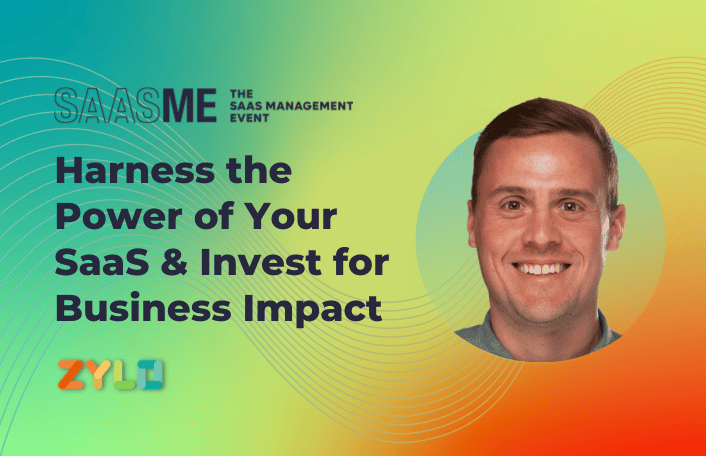10/20/2022
Table of Contents
SaaS is not only here to stay, but continues to grow exponentially as application vendors bring new tools to market.
Case in point: The Marketing Technology Landscape report tracks SaaS vendors in the MarTech space, going back to 2011. In its first year, the report noted around 150 vendors. In 2022, the report lists almost 10,000 MarTech SaaS vendors.
Meanwhile, Zylo’s 2022 SaaS Management Index discovered the average organization has 330 different SaaS applications inside its environment, while Asana’s Anatomy of Work Index found the average knowledge worker switches between 10 apps up to 25 times per day.
“Think about all those different applications your employees are using to get their jobs done, and how much context switching is going on as they’re moving from app to app to app,” said Ben Pippenger, Co-founder and Chief Business Development and Strategy Officer at Zylo, in the keynote session of Zylo’s SaaSMe Virtual event. “These are the apps they’re using to hit their goals and deliver business value back to their organizations.”
And in the hybrid and work-from-home world we’re all in today, cloud applications become the primary way for folks to communicate and collaborate.
“It’s a vital component of your workforce, your workplace, and where employees are truly going to get their jobs done,” Pippenger said. “It’s also very important to note the wave of SaaS really can’t be stopped. The old way of buying and managing software will no longer exist at some point in the near future. You literally have hundreds, or for larger organizations, thousands of software buyers within your companies. It’s a lot to get your arms around, and it’s not changing.”
Pippenger backed up the claim by noting Gartner predicts a majority of the top 20 software vendors will sunset sales of new perpetual software by 2026, requiring shifts to their SaaS or subscription-based offerings, while increasing costs by 35%.
Read on for some of the key points or watch the full session below. For more takeaways and insights, check out additional sessions from our recent SaaSMe Virtual event.
SaaS Presents a New Slew of Challenges
Pippenger noted how the proliferation of SaaS poses several unique challenges for organizations, all of which stem from a lack of visibility into your entire SaaS stack.
Key challenges to SaaS include:
- SaaS is critical: Employees rely on SaaS to get their jobs done and collaborate with teammates, especially in a hybrid workforce. Any disruption in critical applications causes significant impact to business.
- SaaS is expensive: Second only to people, SaaS and software make up the second highest operating expense for businesses today. Without SaaS Management, software costs quickly become unruly.
- SaaS is decentralized: According to Zylo research, 37% of all applications today originate from employee-led purchases — a 12% increase since the start of the pandemic.
- SaaS is risky: Because of decentralization and shadow IT, SaaS invites risk. It becomes hard for IT to track who has access, or if employees should have access in the first place. For instance, where is that data being stored? Do those apps meet the controls and policies you have in place as a business?
- SaaS is complex: If navigating the hundreds of thousands of apps isn’t confusing enough, SaaS vendors frequently go through mergers and acquisitions as companies buy other companies to enhance their capabilities.
SaaS Creates Opportunity for IT and Finance to Come Together
Diving into SaaS Management can be challenging — and often feel intimidating. Just know there’s so much opportunity once you include the right key players and get your arms around it. Step up and seize the opportunity. The organizations seeing the greatest business impact from SaaS Management today bring their IT and finance teams to the table. Here’s why.
Your finance team is interested in the financial implications of your software investments and working with your vendors to leverage the most benefit from your contracts. Your IT team really cares about the compliance and security risks of these applications, and making sure employees have a great user experience. Meanwhile, your employees are choosing applications due to their ability to help them do their jobs.
All of these components need to come together to truly be impactful for the business. You can’t solve SaaS Management challenges in silos. SaaS Management provides the solution to tear down these silos. Without action, your SaaS portfolio and spend will only continue to grow larger.
“You look at the Gartner spend chart, you look at some of the projections around the transition from every software provider to a SaaS-based model. Now’s the time. You’ve got to seize this opportunity,” Pippenger said. “Jump in, reach across the hypothetical table, and partner with your IT and your finance teams. Bring your app owners to the table to really collectively break down those silos to solve the problem.”
Achieving Tangible Results with SaaS Management
To wrap up, SaaS continues to grow, and it’s definitely here to stay. The dynamic nature of SaaS invites risk, from decentralized purchases to spiraling costs. Yet, where there’s challenges, there’s a ton of opportunity. There’s a massive opportunity for IT and finance to truly come together and take ownership of solving SaaS Management. The organizations diving headfirst into SaaS Management today are driving highly impactful results for their business and their employees.
For more on how IT and finance can converge to optimize SaaS Management, watch the full SaaSMe session on-demand.

